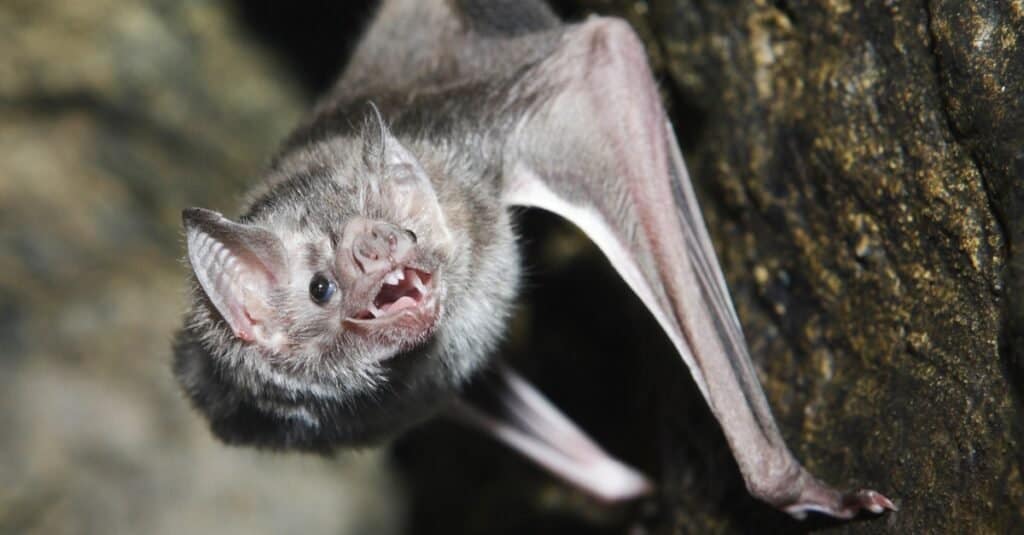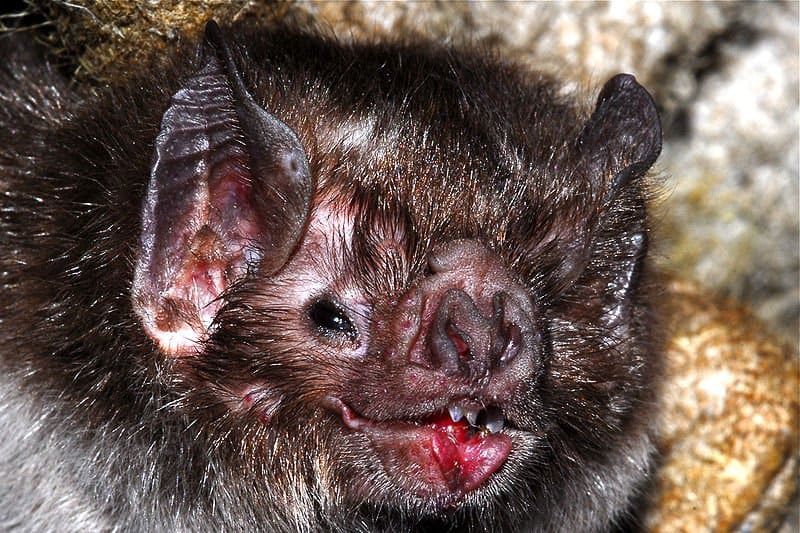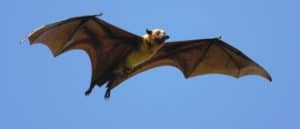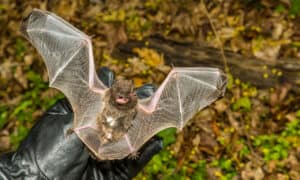The vampire bat is one of the scariest pop-icons in the animal kingdom, although most of the fear is due to their diet and not their actual behavior. Vampire bats are small members of the bat family with three distinct species, the common vampire bat, the hairy-legged vampire bat, and the white-winged vampire bat. Although these small bats are harmless, they are well-known for their exclusive diets of blood, hence the “vampire” designation in their name.
While the moniker may be scary, these animals typically don’t bother humans, and the potential for disease transmission between the two has drastically dropped in recent years. Still, understanding these fascinating animals comes with an appreciation for their niche evolution and diets. Let’s look and learn: What do vampire bats eat?
What do vampire bats eat?

Each night, vampire bats drink about half of their body weight in blood.
©Michael Lynch/Shutterstock.com
Vampire bats eat (drink) blood from warm-blooded mammals, hence the name “vampire bat.”
The infamous vampire bat lives in Central and South America and exclusively lives on blood. Hematophagy (feeding on blood) is a practice unique to only three bat species, all with their vampire moniker. The three species of bats are the only mammals on the earth that only feed on blood. As a result, they are hyper-specialized within their ecological niche.
Although pop-fiction movies and literature would have it seem that vampire bats feed on humans, it rarely happens in the real world. Vampire bats primarily feed on domestic livestock (cows, horses, and goats), but that is mostly due to their abundance. Before large-scale human domestication, it was common for these bats to feed on other wild mammals and occasionally birds. Their dietary source depends on their location, but common prey includes tapirs, deer, peccaries, cattle, monkeys, and birds.
The common vampire bat typically prefers mammals and will target cows and pigs. The other two species (the white-winged vampire bat and the hairy-legged vampire bat) seem to prefer birds and will often go after sleeping chickens.
A complete list of foods vampire bats eat
While vampire bats don’t “eat” anything, they do drink the blood of mammals. Here’s a complete list of animals that vampire bats are known to feed on:
- cows
- pigs
- horses
- goats
- chickens
- tapirs
- small wild mammals
- wild birds
- humans (rarely)
How do vampire bats hunt?
Vampire bats have some of the most unique and interesting feeding strategies of any in the animal kingdom.
A hungry bat will find a potential host using thermoception, usually in total darkness. They only come out at night and hunt when their hosts are usually asleep. This makes it less likely they will be caught. When they land, they never land on their host as to avoid waking them up. Once they are close, they use a heat-seeking adapted nose to locate warm spots on the skin and sheer away hair with their canine and cheek teeth. Once the skin is revealed, they use razor-sharp incisor teeth to make a 7×8 mm cut. Their upper teeth don’t have enamel to keep them as sharp as possible. Museum handlers have been known to cut themselves just from handling their skulls.
Once the skin has been cut, their saliva has enzymatic compounds that slow clotting and slightly numb the area. With the cut numbed and freely bleeding, the bat then places its channeled tongue under the cut and laps up the blood. In a single sitting, a vampire bat can drink 20 grams of blood or about half its body weight. With a rapid digestive system to aid in flight, the bat is able to urinate excess weight and take off.
How did vampire bats evolve to drink blood?

Vampire bats use thermoception to locate their hosts. After a small cut made with razor-sharp teeth, they lap the flowing blood.
The evolutionary journey of vampire bats shows us just how they became the “bloodsuckers” they are today. Although the science isn’t totally solidified, we can still learn quite a bit about their history.
Vampire bats are in a family known as “New World leaf-nosed bats”. Within this family are bats that feed on nectar, pollen, fruit, meat, and insects, as well as blood. Vampire bats evolved within this family, although hematophagy isn’t a common path in the animal kingdom abroad due to how difficult it is to biologically overcome. Often, mammals need to overcome iron poisoning, excess protein, and excess liquid to ever path into hematophagy.
There are a few theories that explain how vampire bats specialized in hematophagy. Recent research points towards the first ancestors being insect eaters. This would discount the various origin theories rooted in fruit, meat, and nectar-eating bats. It’s possible that the ancient ancestors of vampire bats originally fed on insects that fed on the wounds of large animals. Over time, they slowly adapted to feed on the animals themselves. Another potential theory is that the earliest bats fed on other ectoparasites (ticks, fleas, and lice) and developed the ability to tolerate blood through their prey.
However the method of evolution, it’s clear that all three species are closely related to one another and came from a shared ancestor. It’s also likely that the first vampire bats split from their “family” and into a distinct genus within 4 million years, setting a potential record for our fastest examples of mammalian natural selection.
Are vampire bats dangerous to humans?

Vampire bats can prey on humans, but it is rare and usually harmless.
While humans are large mammals with lots of potential blood to be “sucked,” we generally don’t need to worry about vampire bats eating us. If you live in Central or South America and sleep outside, it’s possible that a vampire bat could decide to feed on you. When this does happen, the human is rarely aware of it until the next morning, and a small cut is all that’s left. While bats carry rabies, they aren’t usually able to fly with the disease as they are disoriented. With all these factors, vampire bats aren’t much concern for humans.
Additionally, dogs can become prey for the bats, but many are already vaccinated against rabies. Since the blood loss is minor, it’s usually unknown when it does happen.
The photo featured at the top of this post is © Gcarter / Creative Commons / Original
Thank you for reading! Have some feedback for us? Contact the AZ Animals editorial team.







